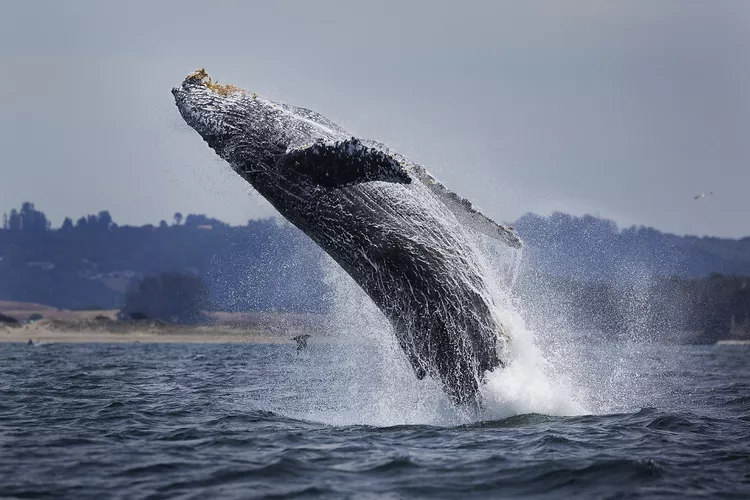Summary
Whale Watching in Southern California
If you’re traveling to southern California and are a fan of the open ocean and marine life, you can spend the day whale watching in Los Angeles and Orange County either on the coast or on a cruise of the Pacific Ocean.
Whale Watching Overview
You can catch boat tours departing from the Aquarium of the Pacific in Long Beach or from facilities in Redondo Beach, Newport Beach, Dana Point, and San Pedro. Alternatively, you can often catch a glimpse of whales right off the coast along the Pacific Coast Highway; either way, the ocean-enthusiast in your family is sure to enjoy a diversion to see these huge aquatic animals in person.
According to CBS Los Angeles, winter and summer have become the preferred seasons for sightings and whale activity off the coast of southern California, as most species are prone to migrating south from Alaska to Baja, California, where they can mate, give birth, and prepare for the colder water in their northern home.
How to Spot a Whale and Other Tips
Whether you’re out on the ocean or along the coast, being able to identify what a whale looks like from afar will go a long way in getting to experience seeing a whale in person. The easiest way to identify these magnificent creatures is by looking out for a spout of mist that whales produce when they come up for air—which is usually visible from a good distance and is likely to be the first sign of a whale.
If you’re out on the ocean, you can look for flat patches on the water, which indicate that the whale is about to surface. You can also follow groups of birds diving for fish, which is a good indication that dolphins, sea lions, or even whales are probably feeding there, too. Moreover, remember to dress in layers and dress warmly. Regardless of the season, it is cold out on the water. Even when it’s really hot at the beach, it’s cool out past the breakwater. In winter, dress like you’re heading to the snow.
Be sure to take your camera or a pair of binoculars for getting a close-up view of whales and other sea life, but use your naked eyes first for spotting signs of whales in the distance.
Whale Watching Seasons
Many species of whales can be seen off the coast of California year-round, but especially during the winter and summer migratory seasons. According to volunteers at the Aquarium of the Pacific, there have been gray, sperm, humpback, blue, fin, and Minke whales sighted on their whale watching tours. There have also been rare glimpses of pygmy sperm, pilot, killer, false killer, Cuvier’s beaked, and Stejnegers beaked whales in the San Pedro Channel off the SoCal coast.
Gray whales, the most prevalent of the species cleaving our waters, migrate 6,000 miles south every October from their feeding grounds in the Bering Strait to mate and calve in the warm lagoons of Baja, Mexico. Prime whale watching season is from January through April when the mamas return north with their young. Gray whales get to be about 52 feet long and are a splotchy gray and white due to parasites that attach to them in the warm water and fall off again when they head north.
In the summer, another rarer species, the North Pacific Blue Whales, have been migrating along the west coast since 2007. The blue whale is the largest mammal that ever lived, bigger than any dinosaur remains that have ever been found. They grow to 108 feet and weigh up to 190 tons (380,000 pounds). According to marine biologists, the blue whales that migrate along the west coast have begun feeding on a variety of tiny krill that lives closer to the coast, possibly due to climate change, bringing these majestic creatures into public view about 5 miles off the coast during the summer months.
Since around 2015, pods of orcas, or killer whales, which usually migrate farther out to sea, have also been spotted on whale-watching excursions in November and December.
Off-Season and Year-Round Whale Sightings
Of the other whales that may appear off the coast of southern California, fin whales are the most likely to appear year-round. Fin whales are the second largest mammal, reaching up to 88 feet long, and although they are endangered, their populations are spread out across many oceans and their migratory patterns are not well understood. Consequently, you might only catch them off the coast of SoCal on occasion, and it could happen any season.
Another whale species you might see in the off-season is the humpback whale, whose adults range in length from 40 to 50 feet and often appear from April to June. These whales are particularly acrobatic, so you might see them splashing about on the surface of the ocean in addition to coming up for air. Check for local whale spotting reports before planning your whale watching trip in the spring.
In between whale migrations, the whale watching excursions become dolphin and sea life tours, since half-a-dozen dolphin varieties, as well as sea lions and seals, can usually be found in our waters all year long.




